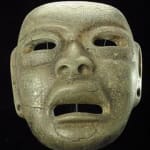Olmec Greenstone Mask, 900 BCE - 500 BCE
Greenstone
5
PF.4094
Based on archaeological and linguistic evidence, the ancient civilization of the Olmecs appears to have taken root and blossomed in the low-lying Gulf Coast area of modern Mexico around 1200...
Based on archaeological and linguistic evidence, the ancient civilization of the Olmecs appears to have taken root and blossomed in the low-lying Gulf Coast area of modern Mexico around 1200 B.C. Considered to be the first civilization of the Americas, many aspects of Olmec culture would be absorbed by the civilizations that came after them. The Maya, for instance, were directly influenced by their city centers based around large platform mounds and their hieroglyphic language. However today, the Olmecs are known primarily for the distinctive works of art they left behind. Olmec art was primarily a reflection and result of their religion. The Olmecs believed that a union of jaguar and woman produced an earlier race of were-jaguars. Depictions of human infants with the snarling mouths of jaguars are a reoccurring motif of Olmect art. These were-jaguar babies are thought to function both as symbols of fertility and of the shape-shifting powers of the shaman. The Colossal Heads, a series of massive stone portraits of their rulers, are perhaps the most celebrated works of Olmec art. Olmec artists also commonly worked with jade and greenstone, which they believed had beneficial properties linked to fertility and procreation.
The facial features of this greenstone mask are characteristic of Olmec art. The down turned mouth of the were-jaguar is thought by scholars to depict a shaman in the midst of transmogrification. Its harmonious proportions are indicative of the sophistication attained by Olmec sculptors. The smooth, highly polished surface of the stone has been engraved with abstract linear motifs along the forehead and fleshy cheeks. The eyes and mouths are open, the nose slightly upturned. Holes drilled in the earlobes may have once been decorated with inlays of shell. While it is possible this mask was worn by a living individual during a ceremonial celebration, it is far more likely that it served a funerary function. The preservation of the physical remains of the dead through mummification was a central concern of Olmec burial rites. Masks of jade and greenstone were traditionally laid over the wrapped remain of important individuals who had passed away. As great civilizations rise and fall, they leave behind traces of their existence. Ritualistic objects, venerated in their own time, continue to exert an eternal force long after they have left the hands that once held them sacred. A mysterious energy still radiates from this greenstone mask, a testament to the artistry and culture of the ancient Olmec civilization.
The facial features of this greenstone mask are characteristic of Olmec art. The down turned mouth of the were-jaguar is thought by scholars to depict a shaman in the midst of transmogrification. Its harmonious proportions are indicative of the sophistication attained by Olmec sculptors. The smooth, highly polished surface of the stone has been engraved with abstract linear motifs along the forehead and fleshy cheeks. The eyes and mouths are open, the nose slightly upturned. Holes drilled in the earlobes may have once been decorated with inlays of shell. While it is possible this mask was worn by a living individual during a ceremonial celebration, it is far more likely that it served a funerary function. The preservation of the physical remains of the dead through mummification was a central concern of Olmec burial rites. Masks of jade and greenstone were traditionally laid over the wrapped remain of important individuals who had passed away. As great civilizations rise and fall, they leave behind traces of their existence. Ritualistic objects, venerated in their own time, continue to exert an eternal force long after they have left the hands that once held them sacred. A mysterious energy still radiates from this greenstone mask, a testament to the artistry and culture of the ancient Olmec civilization.



